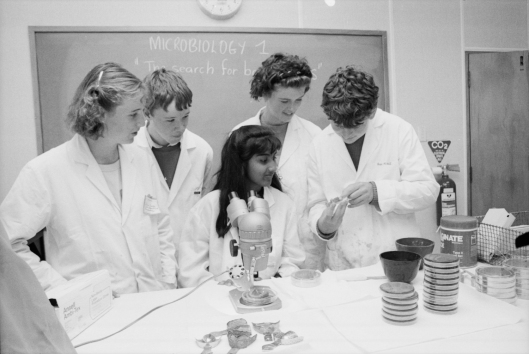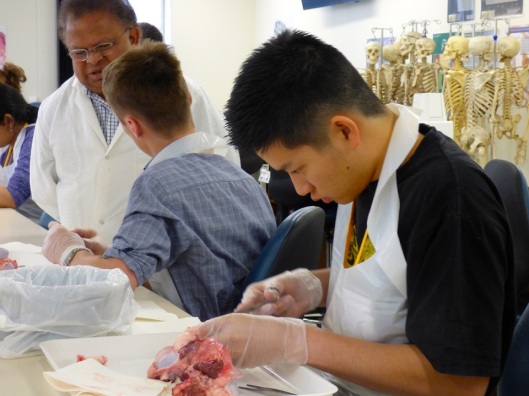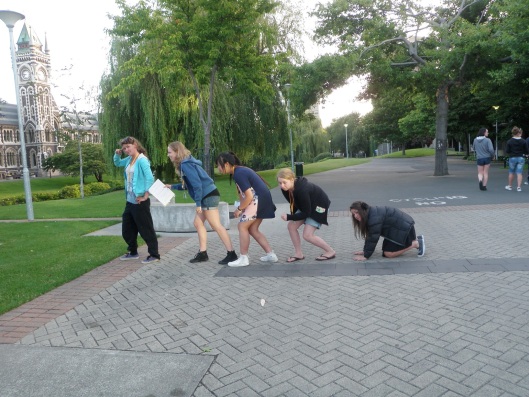Tags
1980s, 1990s, 2000s, 2010s, anatomy, chemistry, computer science, mathematics, microbiology, neuroscience, physical education

Looking at bacteria on an agar model of a set of teeth during the microbiology project at the first Hands-on science camp, 1990. Image courtesy of the Hocken Collections, University of Otago Photographic Unit records, MS-4185/042, S15-500d.
Recruiting good students is a priority for every university department. Everybody wants to attract the brightest and the best, but there is no shortage of competition from other subjects and other universities. Attracting interest early is essential, for once students have dropped a subject in school, they are unlikely to consider it as an option for tertiary study. In 1987 Donald McGregor, Dean of Otago’s Faculty of Science, noted “grave and widespread concerns over science and mathematics education in New Zealand”. Students were less well prepared than a few years earlier, many were turning away from science at an early age, and a much smaller proportion of the brightest students were enrolling in tertiary science courses.
Some individual science departments had already established programmes to promote their subjects in schools – for example, in 1985 the Department of Mathematics and Statistics started a junior maths competition and, together with the Department of Computer Science, organised a national computer art competition. Now the Science Faculty set up a Science-Link Committee to foster links with schools and promote science in the community, and also a Science Education Forum for concerned educators to support one another in advancing science and maths education at all levels in Otago. University scientists took part in a wide variety of activities to promote science in schools, ranging from more competitions and science fairs to an adopt-a-scientist programme and a junior chemistry club (for intermediate school children).
One of the boldest new schemes of the Science Education Forum had a national reach and included all of the sciences. Hands-on science brought a group of secondary students of ‘exceptional’ ability to Otago in January 1990 for a week of science activities – Gerry Carrington, convenor of the organising committee, described it as an “outward bound school for scientists”. The first science camp was an enormous success, setting a pattern which has continued ever since. In the mornings students worked in small groups on a challenging project designed by one of the university departments and guided by staff and tutors. The afternoons were taken up by a more relaxed recreation programme, allowing them to explore the Dunedin environs. Participants from out of town – about 100 of the 140 involved that first year – stayed in one of the residential colleges, and organisers arranged sponsorship for those who could not afford the expenses.

Some intense work underway during the anatomy project at Hands-on science, 2015. Image courtesy of Hands-on science.
After that first year, described by students as “exciting and inspiring”, Hands-on science became a fixture on the university calendar every January, attracting more applications each year. Eventually the roll settled at around 240, with many turned away (there were 520 applicants for this year’s course). As well as their research projects, students listened to inspiring lectures. A programme of “science snacks”, allowing participants to get a briefer taste of a wide variety of science activities, was later added to the afternoon schedule, though there were still a few purely recreational activities on offer, including quizzes, discos and outdoor challenges.

It’s not all serious! Students demonstrate the ascent of humanity during Campus Capers, a treasure hunt to familiarise students with the campus, 2013. Image courtesy of Hands-on science.
In its first 26 years Hands-on science has proved an effective recruitment tool for the sciences and, more specifically, for the sciences at Otago – around 40% of those attending end up as Otago students. More than half the participants some years are female, so it has helped encourage women into science careers. In more recent years there has also been increasing interest in the programme from Maori, who have been, traditionally, much under-represented in the sciences. Hands-on science has also proved particularly valuable for young people from small towns, giving them an opportunity to meet others with an interest in science.
Unsurprisingly for a programme designed for exceptional students, there have been some remarkable individuals attending Hands-on science. Perhaps the best-known to date is Chris Butcher, one of the engineers who created the Halo computer games. For some, the programme has determined their entire career. Christopher Lind, a 16-year-old from Rangiora, was inspired by Otago’s Brian Hyland, who explained the science of studying the brain and its functions. “I knew right then I wanted to be a neurosurgeon… I thought the brain sounded interesting and brain surgery was a frontier science”, he commented to the Otago Daily Times when he returned to Dunedin for a conference in 2009. Lind graduated in medicine from Otago and is now a neurosurgical professor in Perth, Australia.
With stories like this it is no wonder the people behind Hands-on science felt reason to celebrate last year when they held the 25th programme! Do you have any stories to share of Hands-on science? And can you help identify any of the participants in the photographs?


Pingback: Photo mysteries | University of Otago 1869-2019